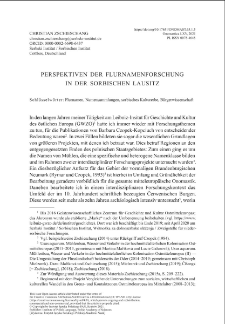
Object
Title: Perspective of the research on microtoponyms Sorbian Lausitz
Publisher:
Instytut Języka Polskiego Polskiej Akademii Nauk
Place of publishing:
Description:
Abstract:
When it comes to investigating minor place names, there is a broad range of methods available, reflect- ing the heterogeneous nature of this class of proper names. Probably the most suitable approach is to examine microtoponyms from the angle of an individual settlement within its boundaries, since it is home to a specific communication community. Seen from this perspective, it becomes appar- ent that instead of merely a set of individual names, microtoponyms represent a tangle of relations between these names as well as of concepts and analogies, etc.To obtain an extensive picture of this tangle, as many sources as possible need to be considered. When presenting minor place names as part of Sorbian cultural heritage, a specific situation applies: the high number of different regional and local collections. Many of them have been published: some cover large parts of Lusatia, while others are confined to individual settlements; some of them are ono - mastic studies with extensive analyses, others are merely uncommented lists of names. Furthermore, there are several handwritten collections in the archives comprising thousands of names. Substantial parts of the study areas overlap. Although one might expect the same names to be found in these different collections, there are in fact remarkable divergencies, as demonstrated here by an example.All in all, Lusatia offers diverse material for research on minor place names. Moreover, the fact that many people are still interested in these names presents a good opportunity for citizen science, which could and should play an important role in future research.
Relation:
Volume:
Issue:
Start page:
End page:
Detailed Resource Type:
Format:
Resource Identifier:
click here to follow the link ; oai:rcin.org.pl:233344
Language:
Language of abstract:
Rights:
Terms of use:
Copyright-protected material. May be used within the limits of statutory user freedoms
Access:
Object collections:
- Institute of Polish Language PAS
- Institute of Polish Language PAS > Filds of science
- Institute of Polish Language PAS > Serials
- Institute of Polish Language PAS > Filds of science > Humanities
- Institute of Polish Language PAS > Filds of science > Humanities > Linguistics
- Institute of Polish Language PAS > Filds of science > Humanities > Linguistics > Onomastics
Last modified:
Feb 3, 2022
In our library since:
Jan 26, 2022
Number of object content downloads / hits:
104
All available object's versions:
https://rcin.org.pl/ijp/publication/270370
Show description in RDF format:
Show description in RDFa format:
Show description in OAI-PMH format:
| Edition name | Date |
|---|---|
| 2021, Perspektiven der Flurnamenforschung in der sorbischen Lausitz / Zschieschang, Christian | Feb 3, 2022 |
Objects Similar
Udolph, Jürgen

 INSTYTUT ARCHEOLOGII I ETNOLOGII POLSKIEJ AKADEMII NAUK
INSTYTUT ARCHEOLOGII I ETNOLOGII POLSKIEJ AKADEMII NAUK
 INSTYTUT BADAŃ LITERACKICH POLSKIEJ AKADEMII NAUK
INSTYTUT BADAŃ LITERACKICH POLSKIEJ AKADEMII NAUK
 INSTYTUT BADAWCZY LEŚNICTWA
INSTYTUT BADAWCZY LEŚNICTWA
 INSTYTUT BIOLOGII DOŚWIADCZALNEJ IM. MARCELEGO NENCKIEGO POLSKIEJ AKADEMII NAUK
INSTYTUT BIOLOGII DOŚWIADCZALNEJ IM. MARCELEGO NENCKIEGO POLSKIEJ AKADEMII NAUK
 INSTYTUT BIOLOGII SSAKÓW POLSKIEJ AKADEMII NAUK
INSTYTUT BIOLOGII SSAKÓW POLSKIEJ AKADEMII NAUK
 INSTYTUT CHEMII FIZYCZNEJ PAN
INSTYTUT CHEMII FIZYCZNEJ PAN
 INSTYTUT CHEMII ORGANICZNEJ PAN
INSTYTUT CHEMII ORGANICZNEJ PAN
 INSTYTUT FILOZOFII I SOCJOLOGII PAN
INSTYTUT FILOZOFII I SOCJOLOGII PAN
 INSTYTUT GEOGRAFII I PRZESTRZENNEGO ZAGOSPODAROWANIA PAN
INSTYTUT GEOGRAFII I PRZESTRZENNEGO ZAGOSPODAROWANIA PAN
 INSTYTUT HISTORII im. TADEUSZA MANTEUFFLA POLSKIEJ AKADEMII NAUK
INSTYTUT HISTORII im. TADEUSZA MANTEUFFLA POLSKIEJ AKADEMII NAUK
 INSTYTUT JĘZYKA POLSKIEGO POLSKIEJ AKADEMII NAUK
INSTYTUT JĘZYKA POLSKIEGO POLSKIEJ AKADEMII NAUK
 INSTYTUT MATEMATYCZNY PAN
INSTYTUT MATEMATYCZNY PAN
 INSTYTUT MEDYCYNY DOŚWIADCZALNEJ I KLINICZNEJ IM.MIROSŁAWA MOSSAKOWSKIEGO POLSKIEJ AKADEMII NAUK
INSTYTUT MEDYCYNY DOŚWIADCZALNEJ I KLINICZNEJ IM.MIROSŁAWA MOSSAKOWSKIEGO POLSKIEJ AKADEMII NAUK
 INSTYTUT PODSTAWOWYCH PROBLEMÓW TECHNIKI PAN
INSTYTUT PODSTAWOWYCH PROBLEMÓW TECHNIKI PAN
 INSTYTUT SLAWISTYKI PAN
INSTYTUT SLAWISTYKI PAN
 SIEĆ BADAWCZA ŁUKASIEWICZ - INSTYTUT TECHNOLOGII MATERIAŁÓW ELEKTRONICZNYCH
SIEĆ BADAWCZA ŁUKASIEWICZ - INSTYTUT TECHNOLOGII MATERIAŁÓW ELEKTRONICZNYCH
 MUZEUM I INSTYTUT ZOOLOGII POLSKIEJ AKADEMII NAUK
MUZEUM I INSTYTUT ZOOLOGII POLSKIEJ AKADEMII NAUK
 INSTYTUT BADAŃ SYSTEMOWYCH PAN
INSTYTUT BADAŃ SYSTEMOWYCH PAN
 INSTYTUT BOTANIKI IM. WŁADYSŁAWA SZAFERA POLSKIEJ AKADEMII NAUK
INSTYTUT BOTANIKI IM. WŁADYSŁAWA SZAFERA POLSKIEJ AKADEMII NAUK
































